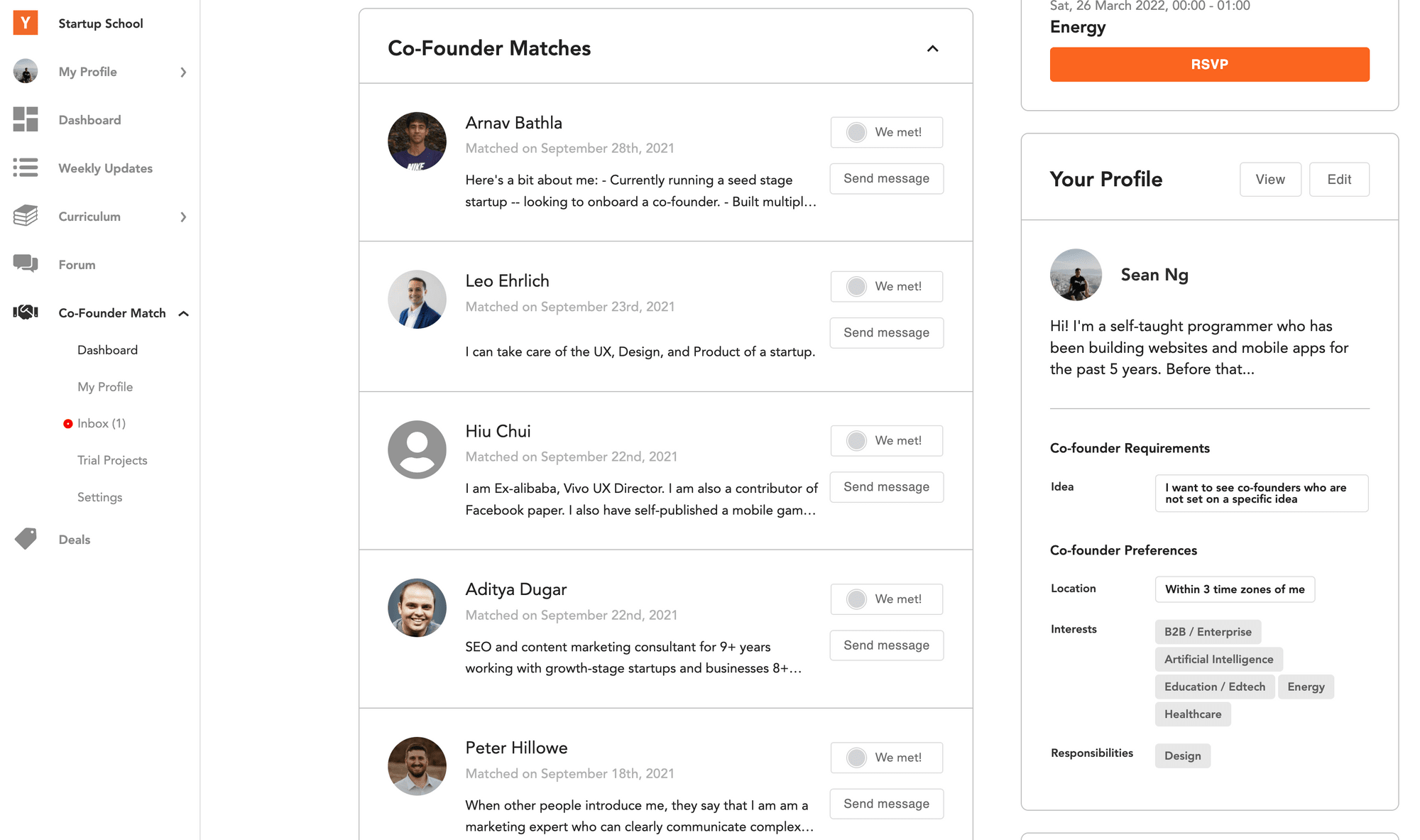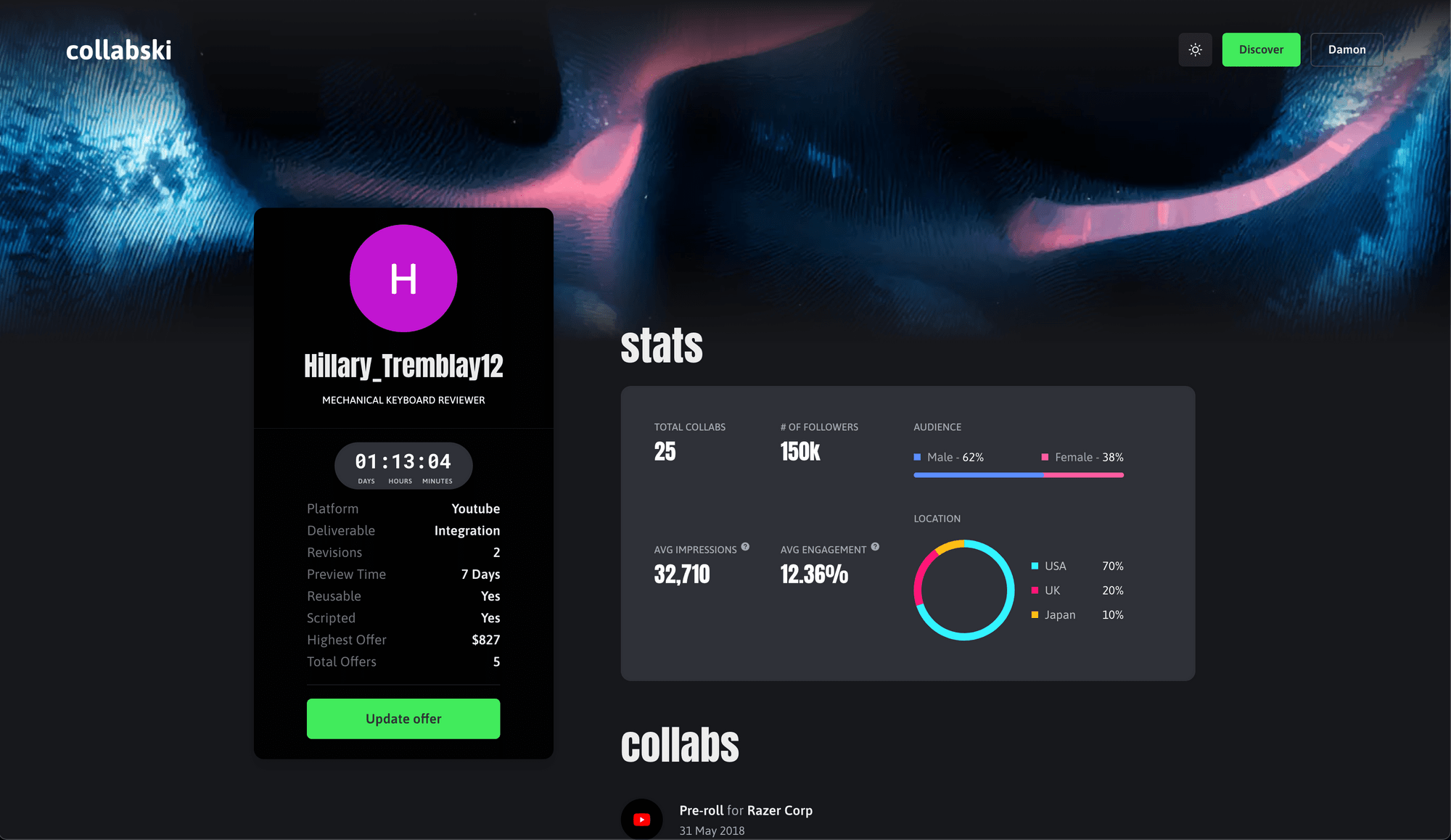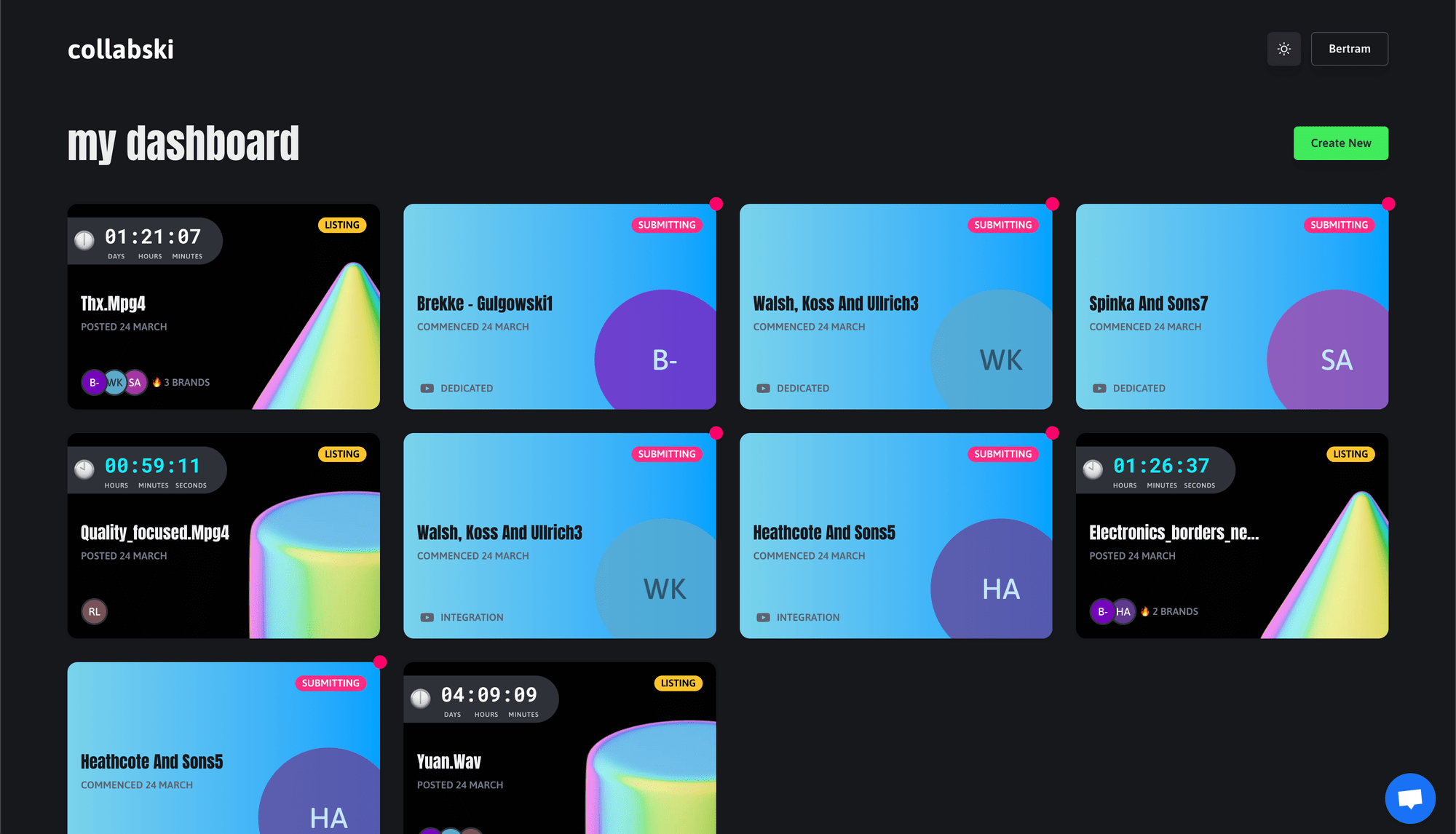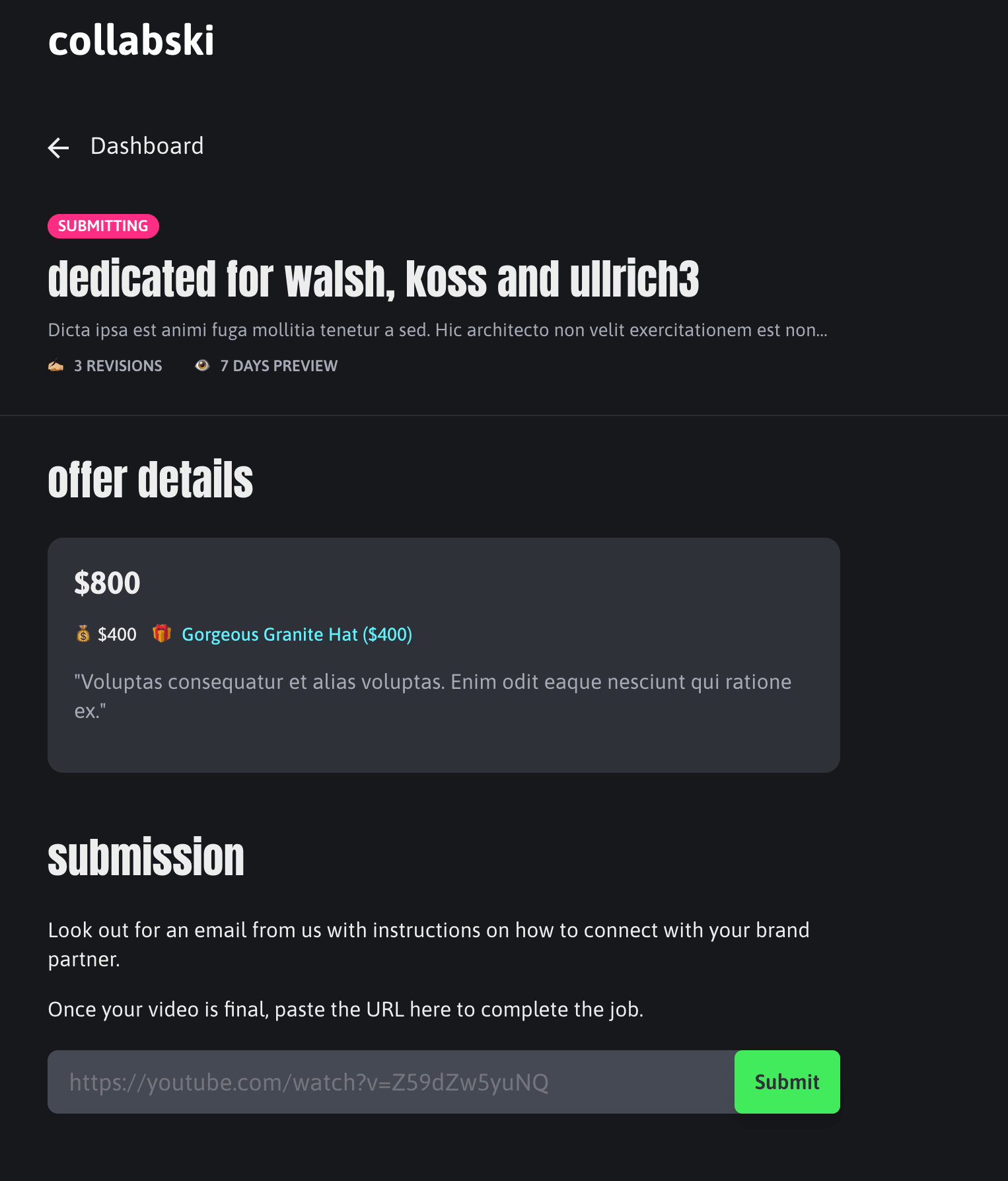Collabski
In the summer of 2021, I stumbled upon Y Combinator's co-founder matching service on on Product Hunt. A month into connecting, interviewing and work-trialling with potential co-founder candidates, I met M. He was an influencer marketer living in LA and he was looking for a technical co-founder to build out a product he had in mind. Through our initial interviews and work trials, we both figured we communicated and worked well together, despite us being across the world from each other. Without much hesitation, we decided to embark on the startup journey together.

Our aim was to build a sponsorship marketplace that connected content creators with brands. We believed we could achieve this through a platform service that simplifies the sponsorship process, enabling content creators to do more sponsorships in less time and with less effort. We took inspiration from DevelopersAuction (now called Hired.com), a platform that solicited highly sought-after software developers and auctioned them to tech companies looking for talent. We wanted to apply that model to highly sought-after content creators and auction their offerings out to brands who were looking to sponsor creators.
M and I had separate roles and responsibilities in the execution and development of the project. I was responsible for building v1 of the platform website (he actually built v0 prior to meeting me), and M was responsible for reaching out to content creators and brands. We chose to start in the mechanical keyboard ("Keeb") niche because M was familiar with the products and knew some of the creators from having worked with them before. Our plan was to then expand concentrically once we had established a presence in this niche.
CNotes
M had actually built an MVP of the platform prior to meeting me. It was called CNotes. We called it v0 internally, because it was a quick and dirty version of the product that we could use to test out various flows before we'd launch v1. CNotes' basic functionality allowed creators to list sponsorship inventory and brands to place offers for them.

CNotes also had a feature that allowed creators and brands to create profiles for other people to learn more about them. We made these profiles public, and leveraged this to acquire content creators who needed a media kit to showcase their profile and portfolio to brands for sponsorships. This was how we managed to acquire our first 50 content creator signups.

Initially, we believed that attracting many content creators to our platform would enhance our reputation and aid our sales efforts in reaching out to brands. However, despite many brands expressing interest in working with us in the future, they were mostly non-committal. It was clear that most of the Keeb brands we reached out to did not feel a need to sponsor the content creators on our platform.
There were many reasons why this might have been the case. One reason was that many of the Keeb brands we reached out to were small, mom-and-pop Etsy studios, who simply did not have the budget for marketing. Another reason was that many of the brands had never sponsored a creator before and simply did not believe that the return on investment was worth it. This was not helped by the newness of the creator economy and the lack of education around sponsoring content creators.
Realizing that we needed to try a different approach, we reached out to Hipyo Tech, a popular YouTuber in the keeb community, who was well-known among many brands. M, having worked with Hipyo Tech before, knew that his name alone could attract Keeb brands. We were able to strike an agreement with Hipyo Tech where we would represent his channel and help him fill out his sponsorship inventory for the upcoming months.
As expected, we were able to find several brands that were interested in sponsoring Hipyo Tech. This allowed us to register them on CNotes and place offers for Hipyo Tech to promote their products in his videos. This approach helped us understand the features we needed to prioritize for v1. We knew that there was a market for creator sponsorships and that companies, even small ones, were willing to pay for creators to promote their products.
During this time, M also felt that we needed a clearer landing page targeting brands, as well as a marketing video to make our brand look more legitimate.
However, the video had to be taken down, as our site also featured a creator who many disliked and did not want to be associated with. This was a problem because creators had found out about the new site through the brands that M was contacting. At this point, we decided to change our name to Collabski because M was certain that our name was being tarnished in several keeb Discord channels. We were panicking because we were receiving spikes of traffic with hundreds of concurrent viewers on our site without having even publicized it yet.
Collabski
It was also around this time (mid December) that I was close to finishing development for v1. Since the platform was built for scale, M took it on himself to find more brands.
The initial idea behind Collabski was to allow content creators to list out their sponsorship slots and specs, and brands to place offers for them. For instance, a creator might want to create promotional space in the beginning of an upcoming video (aka a preroll), so they would list out a preroll for brands to place offers. For more information about how Collabski works, check out the How It Works section on the Collabski website. It should still be up and running (email me if it's down).
The product was designed with a large user base in mind. Brands could find sponsorship listings on the discover page.

If the brand was interested in a listing, they could click into the listing to view more information about the creator and place an offer within the the time period.


Brands could also check their dashboard to update an existing offer. Once the creator agrees to work with the brand, a "Deal" is made. A creator can choose to accept more than one offer, so multiple Deals could spawn off a single Listing. The brand could check out the submission progress in the Deals tab.

Creators also had a dashboard where they could view their current listings and deals.

They could click into a Listing to see an offer history that updates in real time.

And they could click into a Deal to submit the video for review. Deal functionality would depend on the specs of the deal.

Learnings & Future
It pains me to say this, but shortly after the completion of v1, we decided to pivot our idea into an agency. We were unable to register enough interested brands onto our platform, so creators weren't using the platform to list deals. We needed funds but couldn't find an investor either. Nonetheless, I learned a lot during my time working with M. This project was one of the most exciting ones that I've worked on. The creator economy was an emerging sector, and it was extremely motivating to work alongside an influencer domain expert. We worked well together, and I had a lot of faith in our ability to hustle hard and graft through hardships. We worked 12-16 hours a day, six days a week for months. Unfortunately, hard work alone wasn't enough to make it work out. It sucked to learn this the hard way.
Apart from the inability to raise funds to market the product, several other reasons contributed to the project's failure. Firstly, the market opportunity was not as promising as it initially seemed. There wasn't a strong enough demand for creator sponsorships, and many business owners were reluctant to pay or send their product to creators due to the fear of theft. Secondly, there was a lack of education around creator sponsorships, and many business owners in the keeb community were small hobbyists who only cared about making artisan craft rather than marketing their brand. Thirdly, unlike Developer Auction, there wasn't a limited supply of content creators or sponsorship opportunities. Within the keeb niche, there were numerous content creators, and brands could easily find a better deal with smaller channels, at times without needing to pay money. Additionally, due to how frequently creators post videos, there was a surplus of sponsorship inventory.
Personally, I learned the importance of having repeat customers in a service industry. Our platform was a service, and the fact that it wasn't really solving an existing pain for a large market meant that it was important to work closely with an early adopter who could use it. Unfortunately, a platform needed several concurrent users on the demand side, and there just wasn't one.
I also learned to trust my gut. My initial gut reaction when I heard of M's idea to build a marketplace was that such an application was not necessary, since we didn't have a market. M's idea was to build up a marketplace in the same vein Matt Mickiewicz had built up 99designs, Hired.com, and several other marketplaces, but I thought that for a 2-man team this would be extremely operationally intensive and difficult. 1-man if you remove me from the sales equation. Still, I had faith in M to do it because of the grit and conviction he exhibited during our initial weeks working together. It was also a cool economy to be in, and we'd applied to several incubators (YC + TechStars) to get funding.
If I were to work on a project next, it would probably be in a market where I could work with more people. When I say more people, I mean potential customers. In Collabski, we only worked with Hipyo Tech. Sure, he was highly sought after and very valuable to our offerings, but he was not the paying customer. We should really have tried to partner with brands instead. Brands who would use our product repeatedly.
That said, the whole project was a really cool experience. It was tiring since it was so large in scope, but I'd definitely do it again if I stumble upon an opportunity, AND had 1) identified and 2) spoken to potential repeat customers who would be interested in a solution.